Washington State Ferries
Washington State Ferries (WSF) is a government agency that operates automobile and passenger ferry service in the U.S. state of Washington as part of the Washington State Department of Transportation. It runs ten routes serving 20 terminals located around Puget Sound and in the San Juan Islands, designated as part of the state highway system. The agency maintains the largest fleet of ferries in the United States at 21 vessels. In 2022, the system had a ridership of 17,375,400, or about 50,600 per weekday as of the second quarter of 2023. As of 2016, it was the largest ferry operator in the United States[3] and the second-largest vehicular ferry system in the world.[4]
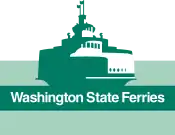 | |
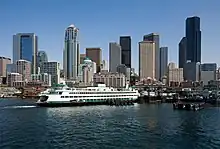 | |
| Locale | Washington |
|---|---|
| Waterway | Puget Sound, Salish Sea |
| Transit type | Ferry |
| Owner | Washington State Department of Transportation |
| Operator | Washington State Department of Transportation |
| Began operation | June 1, 1951 |
| No. of lines | 10 |
| No. of vessels | 21 |
| No. of terminals | 20 |
| Daily ridership | 50,600 (weekdays, Q2 2023)[1] |
| Yearly ridership | 17,375,400 (2022)[2] |
| Website | wsdot |
History
The ferry system has its origins in the "mosquito fleet", a collection of small steamer lines serving the Puget Sound area during the later part of the nineteenth century and early part of the 20th century. By the beginning of the 1930s, two lines remained: the Puget Sound Navigation Company (known as the Black Ball Line) and the Kitsap County Transportation Company. A strike in 1935 caused the KCTC to close, leaving only the Black Ball Line.[5]
Toward the end of the 1940s, the Black Ball Line wanted to increase its fares, to compensate for increased wage demands from the ferry workers' unions, but the state refused to allow this, and so the Black Ball Line shut down. In 1951, the state bought nearly all of Black Ball's ferry assets for $5 million (Black Ball retained five vessels of its fleet).[6] The state intended to run ferry service only until cross-sound bridges could be built, but these were never approved, and the Washington State Department of Transportation runs the system to this day.
During the COVID-19 pandemic, WSF reduced service on most routes and suspended trips to Sidney on the Anacortes–San Juan Islands route. The loss of workers who retired, transferred, or were fired during the pandemic caused delays and trip cancellations as service and ridership began to recover in 2021 and 2022, while vessel replacement also ran behind schedule.[7] By early 2023, full levels of service were restored on four routes but remained limited across much of the system; the Sidney route is not expected to re-enter service until 2030.[8] Staffing issues, particularly among ship captains and mates, continue to prevent the full restoration of service on the Seattle–Bremerton and Fauntleroy–Vashon–Southworth routes.[9] As mitigation for the delay in restoring the Seattle–Bremerton run's second vessel, WSF funded additional trips on the parallel Kitsap Fast Ferries that serves both terminals.[10]
Routes
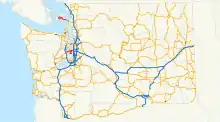
| Route name | Terminals | State route designation[11] | Annual ridership[12] | Annual vehicles carried[12] | Notes | |||
|---|---|---|---|---|---|---|---|---|
| Anacortes–Sidney BC (Service suspended) | Sidney, British Columbia | Friday Harbor, San Juan Island | Anacortes | 123,001 | 42,589 |
| ||
| Anacortes–San Juan Islands | Friday Harbor, San Juan Island | 2,009,438 | 947,064 |
| ||||
| Lopez Island | ||||||||
| Shaw Island | ||||||||
| Orcas Island | ||||||||
| Interisland | Friday Harbor, San Juan Island | Orcas Island | Shaw Island | Lopez Island | ||||
| Port Townsend–Coupeville | Port Townsend | Coupeville, Whidbey Island | 819,285 | 372,130 |
| |||
| Mukilteo–Clinton | Clinton, Whidbey Island | Mukilteo | 4,073,761 | 2,234,650 | ||||
| Edmonds–Kingston | Kingston | Edmonds | 4,114,181 | 2,127,315 | ||||
| Seattle–Bainbridge Island | Winslow, Bainbridge Island | Seattle (Colman Dock) | 6,429,853 | 1,929,617 | ||||
| Seattle–Bremerton | Bremerton | 2,739,926 | 673,815 | |||||
| Fauntleroy–Vashon | Vashon Island | West Seattle (Fauntleroy) | 3,059,587 | 1,738,721 |
| |||
| Fauntleroy–Southworth | Southworth | |||||||
| Southworth–Vashon | Southworth | Vashon Island | 200,672 | 109,548 | ||||
| Point Defiance–Tahlequah | Tahlequah, Vashon Island | Tacoma (Point Defiance) | 812,786 | 473,924 | ||||
Former routes
- Agate Pass, replaced by the Agate Pass Bridge on October 7, 1950[13]
- Edmonds–Port Ludlow
- Port Gamble–Shine, replaced by South Point route on June 10, 1950[13]
- Seattle–Suquamish, discontinued on October 1, 1951
- South Point–Lofall, replaced by Hood Canal Bridge in 1961
- Tacoma Narrows, replaced by Tacoma Narrows Bridge in 1940 but reinstated from 1940 to 1950[13]
Fleet

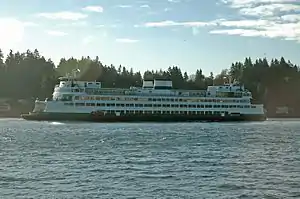
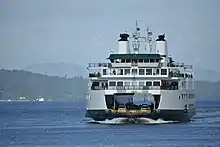
As of April 17, 2020, there are 21 ferries on Puget Sound operated by the state.[14] The largest vessels in this fleet carry up to 2500 passengers and 202 vehicles. They are painted in a distinctive white and green trim paint scheme, and feature double-ended open vehicle decks and bridges at each end so that they do not need to turn around.[15]
WSF plans to electrify its fleet over 20 years. By 2040, it intends to build 16 new hybrid-electric vessels and convert six others to have hybrid propulsion. This will reduce carbon emissions by up 180,000 tons annually and save $19 million per year in diesel fuel costs.[16] The first vessel to undergo conversion to use hybrid-electric propulsion is MV Wenatchee, which will be converted from 2023 to 2024.[17] The program was originally expected to begin in 2022 with a new boat constructed by Vigor Industrial, but cost overruns and disagreements led to delays. Vigor had been the sole shipbuilder for Washington State Ferries since 1997.[18]
As of 2023, 9 of the 21 active ferries maintained by Washington State Ferries are considered to be in good condition. Cancellation of sailings due to mechanical problems and urgent maintenance increased in the 2010s and 2020s.[18]
The ferry fleet consists of the following vessels:[14]
| Class | Ferry name | Year built | Auto
capacity |
Passenger
capacity |
Speed | Notes |
|---|---|---|---|---|---|---|
| Evergreen State | MV Tillikum | 1959 | 87 | 1,061 | 13 kn (24 km/h; 15 mph) | |
| Super | MV Kaleetan | 1967 | 144 | 1,868 | 17 kn (31 km/h; 20 mph) | |
| MV Yakima | 1967 | 144 | 2,000 | 17 kn (31 km/h; 20 mph) | ||
| Jumbo | MV Spokane | 1972 | 188 | 2,000 | 18 kn (33 km/h; 21 mph) | |
| MV Walla Walla | 1973 | 188 | 2,000 | 18 kn (33 km/h; 21 mph) | ||
| Issaquah | MV Issaquah | 1979 | 124 | 1,200 | 16 kn (30 km/h; 18 mph) | Auto capacity increased in 1989. |
| MV Kittitas | 1980 | 124 | 1,200 | 16 kn (30 km/h; 18 mph) | Auto capacity increased in 1990. | |
| MV Kitsap | 1980 | 124 | 1,200 | 16 kn (30 km/h; 18 mph) | Auto capacity increased in 1992. | |
| MV Cathlamet | 1981 | 124 | 1,200 | 16 kn (30 km/h; 18 mph) | Auto capacity increased in 1993. | |
| MV Chelan | 1981 | 124 | 1,200
1,090 International |
16 kn (30 km/h; 18 mph) | Auto capacity increased in 2001. Upgraded to meet SOLAS safety standards for international service on Sidney, BC route in 2005. | |
| MV Sealth | 1982 | 90 | 1,200 | 16 kn (30 km/h; 18 mph) | ||
| Jumbo Mark-II | MV Tacoma | 1997 | 202 | 2,500 | 18 kn (33 km/h; 21 mph) | |
| MV Wenatchee | 1998 | 202 | 2,500 | 18 kn (33 km/h; 21 mph) | ||
| MV Puyallup | 1999 | 202 | 2,500 | 18 kn (33 km/h; 21 mph) | ||
| Kwa-di Tabil | MV Chetzemoka | 2010 | 64 | 750 | 15 kn (28 km/h; 17 mph) | |
| MV Salish | 2011 | 64 | 750 | 15 kn (28 km/h; 17 mph) | ||
| MV Kennewick | 2011 | 64 | 750 | 15 kn (28 km/h; 17 mph) | ||
| Olympic | MV Tokitae | 2014 | 144 | 1,500 | 17 kn (31 km/h; 20 mph) | |
| MV Samish | 2015 | 144 | 1,500 | 17 kn (31 km/h; 20 mph) | ||
| MV Chimacum | 2017 | 144 | 1,500 | 17 kn (31 km/h; 20 mph) | ||
| MV Suquamish | 2018 | 144 | 1,500 | 17 kn (31 km/h; 20 mph) |
Retired vessels
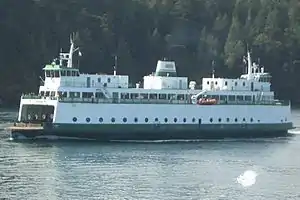
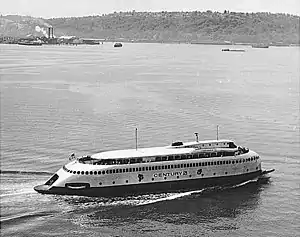
Since the beginning of state-run ferry service in 1951, WSF has retired many vessels as they have become older, too expensive to operate or maintain, or have become too small to provide adequate ferry service. WSF owned passenger-only vessels between 1985 and 2009, but after discontinuing its two passenger-only routes in the 2000s, WSF has sold its passenger-only ferries to other operators.
Below is a list of ferries that WSF has retired since 1951. Unless otherwise noted, all vessels introduced in 1951 were acquired from the Puget Sound Navigation Company (PSN), also known as the Black Ball Line, when the state took over the company's routes and ferryboats in Puget Sound.
| Ferry name | Class | Year built (rebuilt) | Year in service | Year retired | Auto capacity | Passenger capacity | Notes |
|---|---|---|---|---|---|---|---|
| MV Chippewa | None | 1900 (1928/ 1932) | 1951 | 1964 | 52 | 950 | Converted to a car ferry in 1926 |
| MV Leschi | None | 1913 | 1951 | 1967 | 40 | 453 | Previously owned by King County and used on Lake Washington |
| SS San Mateo | None | 1922 | 1951 | 1969 | 50 | 659 | Purchased by PSN in 1941 |
| SS Shasta | None | 1922 | 1951 | 1958 | 55 | 468 | Purchased by PSN in 1941 |
| MV Rosario | None | 1923 (1931) | 1951 | 1951 | 33 | 312 | |
| MV Kitsap (1925) | Anderson | 1925 | 1951 | 1961 | 32 | 325 | |
| MV Crosline | None | 1925 (1947) | 1951 | 1967 | 30 | 300 | Purchased by the state in 1947 |
| MV Kehloken | Wood Electric | 1926 | 1951 | 1972 | 50 | 770 | Purchased by PSN in 1940 |
| MV Kalakala | None | 1926 (1935) | 1951 | 1967 | 110 | 1943 | Originally built as MV Peralta in 1926; rebuilt as Kalakala in 1935 using Peralta's hull |
| MV Enetai | Steel Electric | 1927 | 1951 | 1967 | 90 | 1500 | Purchased by PSN in 1940 and converted to a single-ended ferry |
| MV Willapa | Steel Electric | 1927 | 1951 | 1967 | 90 | 1500 | Purchased by PSN in 1940 and converted to a single-ended ferry |
| MV Chetzemoka (1927) | Wood Electric | 1927 | 1951 | 1973 | 50 | 400 | Purchased by PSN in 1938 |
| MV Quinault | Steel Electric | 1927 (1958/ 1985) | 1951 | 2007 | 59 | 616 | Purchased by PSN in 1940 |
| MV Illahee | Steel Electric | 1927 (1958/ 1986) | 1951 | 2007 | 59 | 616 | Purchased by PSN in 1940 |
| MV Nisqually | Steel Electric | 1927 (1958/ 1987) | 1951 | 2007 | 59 | 616 | Purchased by PSN in 1940 |
| MV Klickitat | Steel Electric | 1927 (1958/ 1981) | 1951 | 2007 | 64 | 412 | Purchased by PSN in 1940 |
| MV Klahanie | Wood Electric | 1928 | 1951 | 1972 | 50 | 601 | Purchased by PSN in 1940 |
| MV Skansonia | None | 1929 | 1951 | 1969 | 32 | 465 | Operated under a state contract since 1940 after the Tacoma Narrows Bridge collapsed |
| MV Vashon | Anderson | 1930 | 1951 | 1980 | 50 | 646 | |
| MV Olympic | None | 1938 | 1954 | 1993 | 55 | 605 | Purchased by WSF in 1954 |
| MV Rhododendron | None | 1947 (1990) | 1954 | 2012 | 48 | 546 | Purchased by WSF in 1954, sold to Atlantic Capes Fisheries in 2013 |
| MV Evergreen State | Evergreen State | 1954 (1988) | 1954 | 2016 | 87 | 854 | |
| MV Kulshan | None | 1954 | 1970 | 1982 | 65 | 350 | Purchased by WSF in 1970, sold in 1982 and renamed MV Governor |
| MV Klahowya | Evergreen State | 1958 (1995) | 1958 | 2017 | 87 | 792 | |
| MV Hyak | Super | 1966 | 1967 | 2019 | 144 | 2000 | |
| MV Hiyu | None | 1967 | 1967 | 2016 | 34 | 199 | |
| MV Elwha | Super | 1967 (1991) | 1968 | 2020 | 144 | 1069 | Upgraded to meet SOLAS standards for Sidney, BC. |
| MV Tyee | None | 1985 | 1985 | 2003 | 0 | 250 | Operating as M/V Glacier Express in Kenai Fjords National Park, Alaska as of 2013[20][21] |
| MV Kalama | Skagit/Kalama | 1989 | 1989 | 2009 | 0 | 230 | Sold in 2011 |
| MV Skagit | Skagit/Kalama | 1989 | 1989 | 2009 | 0 | 230 | Sold in 2011; capsized on July 18, 2012 |
| MV Chinook | Passenger-Only Fast Ferry | 1998 | 1998 | 2008 | 0 | 350 | Sold to Golden Gate Ferries, renamed MV Golden Gate |
| MV Snohomish | Passenger-Only Fast Ferry | 1999 | 1999 | 2008 | 0 | 350 | Sold to Golden Gate Ferries, renamed MV Napa |
Other ferries
There are several other publicly operated, private, and passenger-only ferries in Washington state.
See also
References
- "Transit Ridership Report Second Quarter 2023" (PDF). American Public Transportation Association. September 13, 2023. Retrieved September 21, 2023.
- "Transit Ridership Report Fourth Quarter 2022" (PDF). American Public Transportation Association. March 1, 2023. Retrieved March 29, 2023.
- WSDOT Ferries Division, Washington State Department of Transportation, December 2016. Archived from the original on December 14, 2019.
- "WSDOT Ferries Division Fact Sheet- December 2016" (PDF). WSDOT. Archived from the original (PDF) on 2017-02-21. Retrieved 21 February 2021.
- History of Washington State Ferry system, wsdot.com, retrieved March 15, 2008
- Washington State Ferries begins operations on June 1, 1951, HistoryLink.org, retrieved March 15, 2008
- Saldanha, Alison (August 24, 2022). "WA ferry delays hit highest mark in past decade". The Seattle Times. Retrieved March 1, 2023.
- Kroman, David (March 1, 2023). "WA ferries restores service to some routes, delays others". The Seattle Times. Retrieved March 1, 2023.
- Smith, Matthew (June 8, 2023). "WA State Ferries charts new course amid aging fleet, staffing shortages, pandemic woes". Fox 13 News. Retrieved June 12, 2023.
- Kroman, David (June 20, 2023). "WA ferry service on several routes won't return to normal this year". The Seattle Times. Retrieved June 21, 2023.
- 2004–2005 Official State Highway Map, Washington State Department of Transportation, retrieved March 15, 2008
- "WSDOT Ferries Division- overview and fact sheet" (PDF). Washington State Department of Transportation. January 2017. Retrieved May 25, 2017.
- "Annual Traffic Report 1960" (PDF). Washington State Highway Commission. 1960. pp. viii–ix. Retrieved March 25, 2022.
- Washington State Ferries – Our Fleet, Washington State Department of Transportation, Retrieved June 16, 2020
- "WSDOT Ferries Division Fleet Guide" (PDF). Washington State Department of Transportation. October 2018. Retrieved November 28, 2018.
- "Washington State Ferries System Electrification Plan" (PDF). WSDOT. December 2020.
- Cornfield, Jerry (August 16, 2023). "Washington awards $150M contract to convert ferries to hybrid-electric power". Kitsap Sun. Retrieved August 16, 2023.
- Kroman, David (August 20, 2023). "As Washington's ferry fleet ages, why aren't we building new boats?". The Seattle Times. Retrieved September 7, 2023.
- "The Ghost Fleet of Washington State Ferries". EvergreenFleet.com. Retrieved 5 November 2012.
- M/V Tyee, Evergreen Fleet, retrieved 2013-06-28
- Our fleet of vessels, Major Marine Tours, retrieved 2013-06-28